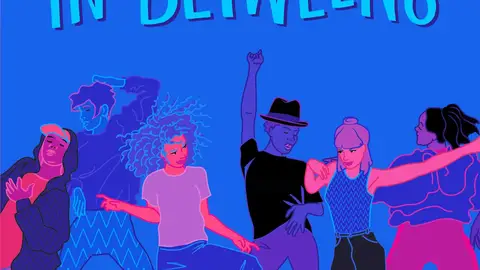This New YA Novel Is “Drag Race” Meets Judy Blume

Somewhere between RuPaul's Drag Race and Judy Blume's iconic Young Adult fiction is Kings, Queens, and In-Betweens, a forthcoming novel from author Tanya Boteju.
The book follows Nima Kumara-Clark, a biracial queer teen from a small town who finds her footing—and her people—after a one-off encounter ushers her into the local drag scene. It's the YA debut for Boteju, a queer English teacher and writer from Vancouver who has some firsthand experience in the world of drag kings, queens, and everybody in between.
Below, read an exclusive excerpt from Kings, Queens, and In-Betweens, out May 7 from Simon and Schuster.
Author Tanya Boteju.
The first time Ginny Woodland spoke to me, I vomited all over her Reeboks.
At the time, I was a haphazard assortment of fourteen-year-old body parts—frizzy black hair sprouting from an unruly ponytail, bug eyes, wide nose, ashy dark skin, practically inverted breasts, and a variety of other genetic hilarities.
She, on the other hand, was a year older, and her body parts were decidedly better suited to one another. Fair skin, freckles, a cascade of fiery red hair—from the neck up alone she was a Botticelli to my Picasso.
Her artistic head bobbed along beside me now—even more beautiful three years later. She’d just finished her shift at Old Stuff, the thrift store where she worked part-time, and I’d biked over to meet her and walk her home—part of a petrifying plan I was no longer sure I could carry out.
Sneaking sideways glances at her as we walked, I could tell she was in a good mood. She was humming some tune I didn’t know and tapping a pebble forward with her toe each step she took. I wished I was as at ease as she seemed. But as my bike rattled along beside me, my heart rattled even more inside my chest. I was trying to generate some magical source of courage to say what I came here to say, but all I seemed able to do was plod along beside her like a dolt, listening to her hum.
Though we’d known each other for three years, somehow that initial nausea had never fully disappeared, even though our relationship had managed to move past that early, revolting debacle.
When I’d first laid eyes on her in the ninth grade, Ginny had been playing basketball in the schoolyard, her lean arms and legs accentuated by a sporty top and knee-high socks, and my heart just about leaped out of my mouth.
Up to that point, my heart hadn’t experienced much in the way of leaping, or thumping, or any similar exertions. Life had been crammed with more “existing” and “observing” than other, action-related verbs. In fact, that September, my best friend Charles and I had made a habit of sitting at the same table at lunch in the schoolyard, under a forlorn cottonwood tree, watching and waiting. We didn’t mind the tree’s patchy shade or despairing limbs—the heart-shaped leaves abandoning their branches and floating down around us felt like a shield against the pandemonium of more boisterous teenagers nearby.
Our tree also provided a great vantage point from which we could safely observe all the high school “flora and fauna,” as Charles called the school’s cliques. He’d fabricate scientific-sounding categorizations for them while I’d invent extended metaphors—two nerdy kids playing a lunchtime game to distract us from the fact that our only friends were heart-shaped leaves.
“Ah look, Nima, there’s the dividas et conquer-ass,” Charles would say, pointing to one of the popular kids in grade eleven who swept past the courts with a trio of minions tailing him. Charles’s full lips would twist into grotesque shapes as he used an unidentifiable accent. “These trees are known to grow in tight clumps for protection, but willeasily turn upon one another if forced to fight for the sun, scraping their way past each other’s tough bark and branches and displacing their own flowering blossoms in the process.” He’d curl his fingers into claws and force them upon one another in a simulated attack, his eyes going cross-eyed.
“Notice,” I’d add, “one member has separated from the group—a single fallen petal from a tree of deceivingly delicate blossoms. What fate will follow for our forgotten friend? Will the damp ground seep into her fine features? Or will some romantic soul pass by, pluck her off the pavement, and savor her forever?”
Admittedly, I could get carried away. When I did, Charles would throw a Froot Loop at me—he always had Froot Loops in his lunch, sometimes for his lunch—and we’d dissolve into giggles.
This was less exciting than some high school experiences, I suppose.
However, it was from the sparse shade of our cottonwood tree that Ginny Woodland—with her athletic body and radiant smile—took hold of my heart and sent it spiraling into a whole host of action verbs.





